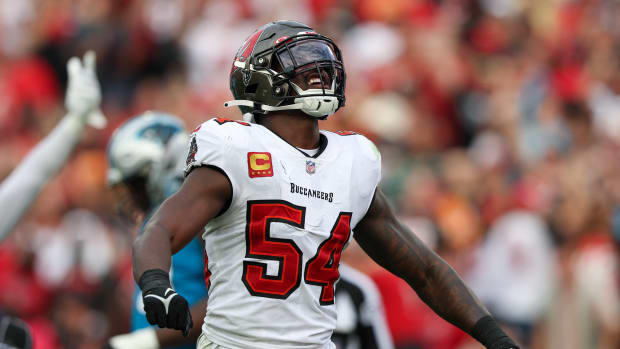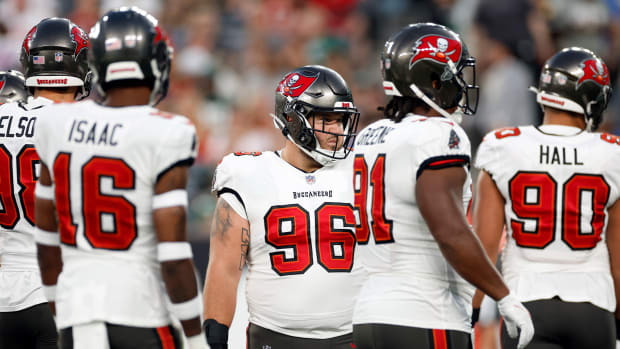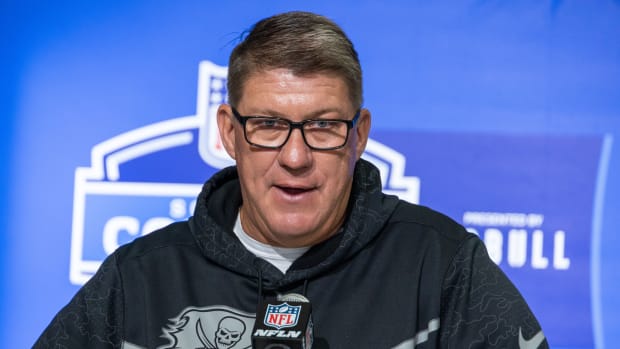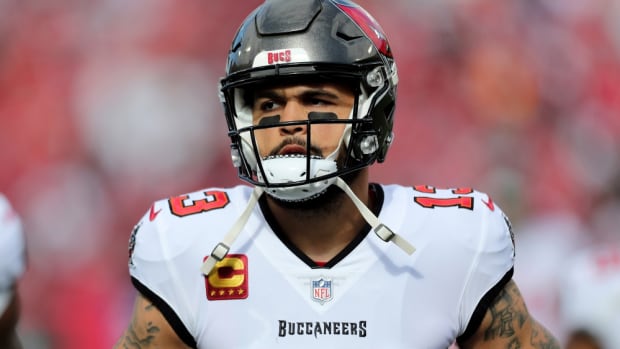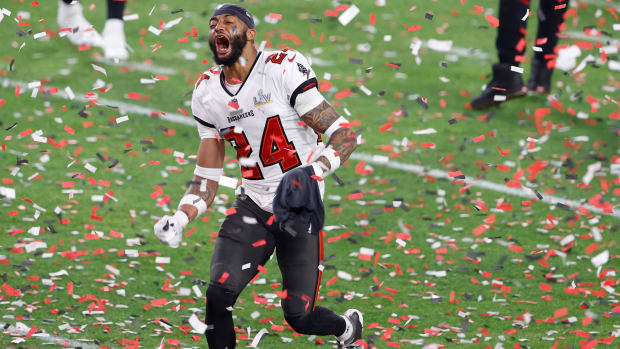Tampa Bay Buccaneers 7-Round Mock Draft: Post-Free Agency Edition
Our second seven-round mock draft for the Tampa Bay Buccaneers is here!
Free agency has all but wrapped up across the NFL, and we have a good sense of where the Buccaneers could best infuse young talent into their roster. The team doesn't really have any glaring needs, but we've compiled a list of positions that could be addressed for the long-term and specific roles that could use an upgrade with a luxury pick. You can find that list here.
With that being said, our second Buccaneers' centric mock draft of the offseason is here! Other than one exception, no selection is a repeated pick from our first mock, and ideally that will hold true in our next and final mock just before the draft.
Following a free agency in which the Buccaneers were able to hold onto their entire starting lineup from the 2020 Super Bowl run, who could they target in the upcoming 2021 NFL Draft?
This mock was created with the help of The Draft Network's mock draft simulator.
1. Christian Barmore, DL, Alabama
Our only repeat-pick from mock draft 1.0, Christian Barmore makes too much sense for the Buccaneers at pick No. 32 should he make it there. And in several draft simulation attempts to test for and prevent flukey picks, he fell into Tampa Bay's laps.
Both head coach Bruce Arians and general manager Jason Licht have suggested that Tampa Bay will approach the draft with the best player available strategy, given a lack of pressing needs, and Barmore fits that bill with the final selection in the first round. He also fills a significant future positional need, which is something the Bucs hope to address throughout the draft if and when possible.
As Ndamukong Suh and William Gholston both enter the final year of their contracts, and will both finish the 2021 season over 30 years old, defensive end is as big of a future need as any for this team. Barmore, a one-year starter at Alabama, can take on a rotational/depth role to develop behind those two in year one before eventually cracking the starting lineup should he pan out.
Barmore is an athletic defensive line prospect that carries great size at a hair over 6-foot-4, 310 pounds with 34 5/8-inch arms. He posted an impressive 4.93-second 40-yard-dash as well, but reportedly came in below average on the shuttle and 3-cone and did not partake in jumps at Alabama's pro day.
Barmore is an effective pass rusher who can play from 0-technique over the center out to 5-technique defensive end, making him an intriguing fit along the Bucs' front three. He commands interior double teams well and is usually successful when deploying inside counter rush moves. We'd like to see Barmore improve his leverage against run blocks against the run and his technique on attacking the outside shoulder of offensive tackles as a pass rusher, which is what makes the idea of Barmore learning from Suh, Gholston, and defensive line coach Kacy Rodgers at his own pace for a year intriguing.
2. Kyle Trask, QB, Florida
Without all too many needs, Arians suggested that the Buccaneers could opt to take a quarterback at some point during the draft, even in the first round if the board falls that way.
We don't see the board falling that way, as the top five quarterbacks will almost certainly be gone before picks get into the double digits and the class severely drops off in talent after that. The next guy up after Trevor Lawrence, Justin Fields, Zach Wilson, Trey Lance, and Mac Jones is widely considered to be Florida's Kyle Trask, a mid-day two prospect.
Trask is not as dynamic of an athlete as the top quarterbacks in this class, arguably other than Jones. He will never be a threat as a rusher beyond short, conversion-style runs (sound familiar?). Trask showed plenty of improvement moving within the pocket to avoid pressure and sacks in his second season as a starter, though, and grew comfortable making intermediate throws on the run.
The embodiment of Trask's game, however, is understanding his reads, making "graduate-level" progressions according to UF head coach Dan Mullen, and completing accurate, timely throws. He can throw with touch and anticipation down the field in place of possessing a cannon-arm, and he thrives with rhythmic RPO and West Coast-style passing concepts.
That doesn't make Trask the most ideal fit for Arians' offense, but Tom Brady wasn't considered the best fit either. And he just led the Bucs to a Super Bowl victory.
And the thing is, Trask knows the drill when it comes to sitting behind quarterbacks on the depth chart until his time comes. A former two-star prospect, Trask didn't start a game from his sophomore year of high school until his redshirt junior season of college - never complaining once.
You probably wouldn't find a quarterback more willing to sit, learn, and be patient behind Tom Brady than Kyle Trask. I've covered Trask for two seasons at Florida, and he was always extremely humble regarding his story and accolades. Although he'd surely like to play sooner rather than later, he doesn't strike me as someone who'd complain about learning the game from Brady for a little while.
3. Tylan Wallace, WR, Oklahoma State (TRADE w/ Los Angeles Rams)
Buccaneers send their 95th (third round) and 217th (sixth round) overall selections, and receive the 88th (third round) overall pick from the Rams.
With Antonio Brown currently out of the picture, the Buccaneers could benefit from adding another playmaker to the offense. Scotty Miller would see his role increase regardless of a rookie coming in, and Tyler Johnson could see a second-year surge as well. But neither exactly replicate the role that Brown filled.
Tylan Wallace may not be a carbon copy of the athlete that Brown is, but he's capable of fulfilling Brown's touches pretty similarly. He was a deep threat from the slot and out wide at Oklahoma State with an average depth of target of 14.8 yards (per PFF), with impressive leaping and stretching ability to make contested catches despite his average 5-foot-11, 194-pound frame.
He also received manufactured touches and thrived on screen passes, leading Power 5 receivers with 309 yards off of screens in 2019. Wallace was motioned into numerous reverse/jet-sweep plays in the Cowboys offense as well. His 4.48 40 yard dash and 6.97 3-cone more than get the job done athletically for this role, although his jumps were a bit below average on pro day.
The mock draft simulator actually offered me this trade as I wasn't particularly looking to move up or down at any point in the process. Sending a sixth-round pick to jump up seven spots is something the Rams would probably consider in reality as Los Angeles owns only six picks and sent several future selections to Detroit for quarterback Matthew Stafford.
4. Shaka Toney, EDGE, Penn State
After Shaquil Barrett signed a four-year extension, the edge rusher position became a non-immediate need for the Bucs. However, Jason Pierre-Paul enters his 12th season as a pro at 32 years old and will be playing on the final year of his contract, which makes edge rusher a future need.
It also never hurts to add a pass-rushing specialist when the value is right, and Shaka Toney presents that type of value in the fourth round.
Toney has work to do as an all-around defensive end or outside linebacker, depending on which scheme he enters at the next level as he's purely a wide edge rusher. However, the Buccaneers could utilize his pass-rushing abilities in a limited role during his rookie year, offering Barrett or Pierre-Paul a breather in sub-packages.
An impressive, 6-foot-2 and a half, 242-pound athlete with 4.55 speed and great results in the vertical (39-inch) and broad (128-inch) jumps, Toney is an ideal project pass rusher and has the production to back it up. He tallied 20 sacks and 28.5 tackles for loss in four seasons (40 games) at Penn State, accumulating 117 quarterback pressures (PFF).
5. Ambry Thomas, CB, Michigan
If there's one starting position that we believe could use some competition this offseason, it's the Buccaneers' No. 2 cornerback position. Jamel Dean is a solid starter but struggled with more agile receivers in the second half of the 2020 season.
A fifth-round pick won't bring much immediate competition, odds are, but Ambry Thomas presents a case to become a contributor sooner rather than later. He's fallen down the draft board after opting out of the 2020 season and dealing with colitis which caused significant weight loss prior to his decision to not play.
However, Thomas strapped it up at the Senior Bowl and proved he could hang. He's a strong press-coverage cornerback with great length despite an average frame at just under 6-foot, and he impressed with a 4.37 40 and 38-inch vertical at pro day. Thomas is physical at the line of scrimmage and offers both the agility to mirror breaking routes and speed to keep up down the field.
Thomas also offers special teams experience as a returner, which the Buccaneers would be wise to add following Jaydon Mickens' March arrest and as Kenjon Barner remains a free agent.
The Bucs have very little depth behind their starting cornerbacks, so expect the team to draft at least one prospect at the position. Thomas fits defensive coordinator Todd Bowles' coverage schemes and provides starting upside, but it's easy to understand why he might slide a bit.
7. Dan Moore Jr., OT/OL, Texas A&M
This is much later than I would have liked to address the Bucs' offensive line depth, but the talent drop-off after the mid-to-late second round among trench prospects is substantial. Tampa Bay returns a starting five that found its groove near the end of the season and into the playoffs though, so finding a prospect who can start or play now isn't a total necessity.
Dan Moore Jr. recorded 35 starts from his time in the SEC at Texas A&M, so he's certainly experienced enough to earn consideration as a depth piece and potential swing tackle. Although he tested well at his pro day, Moore isn't a great athlete for the positioning instead wins with power moving vertically and in short space.
Pair that with his average arm length, perhaps Moore could also move to guard at the next level. However, he held his own against top talent at the Senior Bowl and gave up just 11 sacks on over 2,600 career snaps in college, almost exclusively at left tackle but including a start on the right side.
7. C.J. Marable, RB, Coastal Carolina
Once again, a position that the Buccaneerscouls target much earlier is addressed near the end of the draft. Once again, although Tampa Bay could really benefit from a change-of-pace, proven pass-catching back, the position isn't of utmost importance now as Leonard Fournette re-signed with the teams in free agency.
Still, finding someone who can take on a passing-down role would be ideal. And those types of running backs (really, all types. See: James Robinson) can be found at the end of the draft and even into undrafted free agency. That range is where we find C.J. Marable, an undersized but electric playmaker from the Sun Belt Conference.
Marable is a proven receiving threat with 69 receptions and ten touchdowns across the past two seasons for the Chanticleers. In the same span, he rushed for nearly 2,000 yards and 23 touchdowns at 5.3 yards per carry. He does a good job tracking the ball as his routes extend down the field, and is surely a threat on screens, swings, and checks into the flats.
Marable stood at 5-foot-6, 195 pounds at CCU's pro day, so he's as undersized (but stout!) as they come. That hasn't limited him however, as Marable has played in 36 games over the past three seasons. His athletic test results were great though, as Marabale clocked a 4.53 40-yard dash and 4.34 short shuttle, jumped 36 inches vertical and 116 inches broad, and benched 17 reps of 225.
